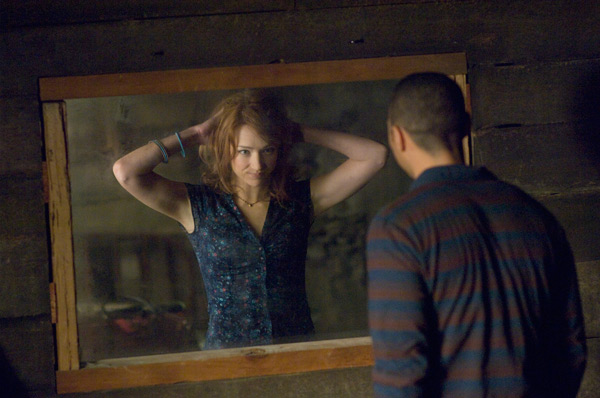Movie review by Greg Carlson
WARNING: The following review reveals plot information. Read only if you have seen “The Cabin in the Woods.”
While major metropolitan critics were asked in preview screenings to avoid any significant revelations contained within the entertaining metafiction titled “The Cabin in the Woods,” any meaningful discussion of the movie would be worthless without the ability to address what amounts to the entire operational conceit of the horror-comedy. In other words, read no more if you plan to see the film. Cooked up by co-screenwriters Joss Whedon (who also produced) and Drew Goddard (who also directed), “The Cabin in the Woods” was shot in 2009 and caught up in MGM’s Chapter 11 problems. Time on the shelf has done little to diminish the movie’s catchy exuberance.
Five coeds pack swimsuits and climb into an RV in anticipation of a weekend frolic at the location of the title, unwittingly cruising into an elaborate trap marking them as human sacrifices. Their every move is monitored and manipulated by the eyes of a massive underground operation led by a pair of eggheads (deadpanning Richard Jenkins and Bradley Whitford) in white, short-sleeved shirts. En route to the remote destination, a stop at a cobwebbed gas station involves an ominous exchange between the travelers and the creepy, tobacco-chewing attendant Mordecai (Tim De Zarn), but needless to say, the kids ignore the harbinger as if they had never seen a horror movie.
Grafting the puppetmaster premise of “The Truman Show” and the less-known “Special Service” episode of the 1980s “Twilight Zone” to the self-referential, filmic Droste effects generated by Wes Craven’s “Scream” (“Cabin” includes a variation on the “rule” proscribing splitting up when in danger) and Sam Raimi’s Ash saga, especially “Evil Dead II,” “The Cabin in the Woods” favors humor over fright, even though the filmmakers jolt the audience with several shocks before an outrageous late-arriving turn where all hell breaks loose. Along the way, the filmmakers identify their own predilections for all manner of cinematic scare tactics, thoughtfully distinguishing between the plain old zombie and the “zombie redneck torture family.”
The vast number of allusions to horror conventions would take multiple viewings to tally, and Whedon and Goddard gleefully pile up references to H.P Lovecraft, EC Comics, lakeside psycho killer series, John Landis and Michael Jackson’s “Thriller,” Japanese ghost stories, and the “anything goes” spirit of Nobuhiko Ohbayashi’s “Hausu.” The film would have been even better had the elevators containing our collective worst nightmares included cameo appearances by additional iconic inspirations such as the key Universal Studios monsters portrayed by Lon Chaney, Bela Lugosi, and Boris Karloff, as well as more recent slashers like Michael Myers, Jason Voorhees and Freddy Krueger.
Sigourney Weaver, whose Ellen Ripley is one of the quintessential “final girls” identified by Carol Clover – despite the lack of any preoccupation with the character’s virginity in “Alien” – pads the “voices of authority” category on her resume, adding “The Cabin in the Woods” to a list that includes “Avatar,” “WALL-E,” and “Paul.” The surprise of seeing Weaver is compromised by her duller narrative function as the denouement “explainer” who nearly blurts “If not for you meddling kids…” Kristen Connolly’s Dana, whose unisex name is another homage to one tradition of final girl protagonists, may be prevented from fulfilling all the criteria associated with the concept of the last survivor standing, but she may earn a spot next to some of the genre’s most tenacious veterans.
